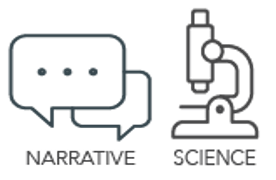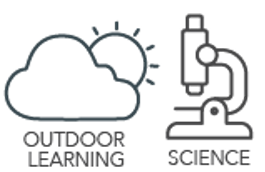Standards + Practices
Science
DCI: ESS2.C The Roles of Water in Earth’s Surface Processes
CCC: Cause and Effect
SP3: Planning and carrying out investigations
Students will conduct a Weather Scavenger Hunt to investigate weather conditions at their location. They will also orient to data collection procedures for contributing to CoCoRaHS.
mathematics
MP6: Attending to precision
Resources + Supports

CoCoRaHS: A Yearlong Exploration of Weather
Ms. Clark has found it difficult to address NGSS standards related to weather because her weather unit occurs over the course of a few weeks in the winter and there is often not sufficient time to cover the various factors that influence the weather. It has been challenging to have students recall conditions from other times of year, and the way they typically discuss weather is often in more relative measures (e.g., warmer and cooler). Hoping to engage students in a more comprehensive study of local weather conditions, as well as regional variation and its causes, Ms. Clark decides to have her classes participate in CoCoRaHS. Although the project focuses on precipitation data, which represents one facet of what Ms. Clark addresses in her instruction, she determines that participating will keep weather concepts on students’ radar throughout the year and will also provide her students with an authentic experience doing science. Students will consistently collect data, recording measurements and other conditions (e.g., temperature, cloud cover, notes on observed precipitation) using a data recording sheet and then on a monthly basis, students will engage in activities that allow them to identify patterns within their observations and measurements for their own locations and others’ to make sense of these data. Additionally, working with CoCoRaHS data will provide opportunities for students to work with decimals and numerical data sets in a meaningful context. Ms. Clark will be able to build on these experiences during her weather unit in the winter, and will then use that unit to lead into spring CoCoRaHS activities.
Because Ms. Clark teaches five sections of 6th grade science, she decides on rotating data collection (reading the rain gauge) among her classes. Her 1st period class, which starts at 8:20am will record the precipitation reading through the end of September before shifting the responsibility to her 2nd period class in October and so on as the year progresses. To ensure accuracy for CoCoRaHS, she will make sure that students attend to the time entered when recording the reading. For the first several weeks of school, she decides that on days where there is precipitation in the rain gauge in the morning, she will take a picture of the gauge to share with her other classes. In addition, because her rain gauge is positioned within site of her classroom window, when it is actively raining, she will allow a pair of students to go out to see the reading at that point in the day. Although they will not formally record these data, she thinks it will help maintain student enthusiasm.

Types of Precipitation
Participating in CoCoRaHS provides students with opportunities to measure precipitation, typically in the form of rain. More information on precipitation, including different types of precipitation, can be found here: https://scijinks.gov/precipitation/. Measurement is a critical component of planning and conducting investigations. Take time to help students understand the importance of using consistent measuring tools and practices to increase the validity of their data. Measurements taken throughout the year will produce data that will be used as evidence in students’ explanations. In addition, scientists rely on these data, and it is very important that all participants contributing to CoCoRaHS measure and record data using the designated rain gauge and procedures (e.g., reading the bottom of the meniscus, reading at a consistent time each day to ensure a 24-hour period has elapsed).
Climate and Weather
Precipitation is one condition included in weather and climate calculations. Sixth grade students have likely heard the terms weather and climate, but will probably need support to fully understand how they are similar and different. The “Climate vs. Weather” article from the media guide can help support students as they think about weather, climate, and how the measurements they take this year will contribute to understanding both weather and climate for their area.
- Weather conditions are reported for single time points.
- Climate values represent averages of weather conditions over time.

Weather Scavenger Hunt
The initial weather scavenger hunt may provide an opportunity for you and your students to determine a suitable location for installing the CoCoRaHS rain gauge. The video to the right is primarily intended for teacher background knowledge but a short excerpt (1:18-1:54) provides guidance on placing the rain gauge.
When taking students outside for science observations and inferences, consider focusing students on their senses for data collection. How does the temperature feel? What odors do they smell? What can they hear? What do they see? Students will engage their senses during the Weather Scavenger Hunt, and it is important for students to recognize that scientists use tools to help them supplement what they can learn from their senses.
You may choose to have students complete the Weather Scavenger Hunt more than once throughout the year in order to better understand how the weather and their schoolyard changes over time. Each time students complete the hunt, engage them in discussion comparing findings from their last weather scavenger hunt.

Using Decimals
To read and record rain gauge measurements, students will be using decimals. It may be helpful to take stock of students’ understanding of decimals, and review how decimals are another way of writing fractions. For example, you can provide students with decimals that represent benchmark fractions they are familiar with (e.g., 0.25 =¼ , 0.5= ½).
Students may have had experience asking, “Does this make sense?” when considering whether their answer to a mathematical problem is reasonable. This approach also applies to students’ data collection. When reading the rain gauge, students can consider whether the amount they are recording “makes sense” given what they’ve observed in the weather. For example, if they’ve observed only a small amount of rain in the rain gauge, a measurement of 0.25 would make sense, whereas a measurement of 2.5 would indicate that additional water would have been present in the outer cylinder.

Who Uses CoCoRaHS Data?
To fully engage with the project, students would benefit from knowing who uses the data collected on the CoCoRaHS website. “Who Uses CoCoRaHS Observations” details who uses the data and why it might be useful to them. In addition, the following links also highlight CoCoRaHS data users:
- Slide 10 of the Training Slide Show
- CoCoRaHS for Schools video (1:40-2:19)
The interactive CoCoRaHS maps will be an important tool for students to become familiar with throughout the year.

Explore the CoCoRaHS map with students, or allow students time to navigate the map, allowing them to see how they are contributing to an effort along with other individuals across North America. There are several settings for the map, some of which are highlighted in later months’ materials. Note that the default map setting only displays measurements taken between 4:30-9:30am local observation time, but this window can be adjusted in the “When” section of “Map Options.” In addition, the default settings for the key are “dynamic,” meaning that the increments/coloring coding of the legend adjust based on each day’s findings, which is important to point out to students. The key can be changed to “static” in “Map Options,” which is suggested for making day-to-day comparisons later in the year.

Collecting Data
Why do certain protocols have to be followed for rain gauge data collection?
- People across the United States and beyond collect CoCoRaHS precipitation data, and CoCoRaHS relies on participants to collect data in the same way to ensure accuracy.
- Mindfully collecting data from a well-placed, recommended rain gauge engages students in the same practices as scientists who collect precipitation data.
- Measuring with accuracy using a protocol allows students to compare measurements across time and location with others.
Where can I find more information on setting up and using our rain gauge?
- CoCoRaHS offers guidance for placing your rain gauge:
- Slides 16-24 of Training Slide Show (rain gauge placement)
- Slides 25-42 of Training Slide Show (measuring rainfall)
- Equipment and Measurements (more information about rain gauge and measurements)
- As a class, consider the best location for your rain gauge that follows the recommended guidelines and is easily accessed by students.
How do I help my students with rain gauge data collection to ensure accuracy and precision?
- Determine routines that work for your students in collecting data.
- To the extent possible, read the rain gauge at the same time each day.
- Train all students on how to read the rain gauge, but consider the best method for your class to collect daily measurements. (If you teach multiple classes, revisit recommendations for participating with multiple groups of students.)
- Rotate 2-3 students to read and report.
- Visit the rain gauge as a class to read and report.
- Take 1-2 students with you before the school day begins to read and report.
- Have a classroom device (e.g., computer, tablet) bookmarked with the CoCoRaHS site for daily data entry.
- Decide how data will be collected over a weekend (e.g., use the multi-day report option or travel to school to record the readings over the weekend).
- Have students record the daily measurements in their science notebooks or in a class recording sheet to have data readily accessible. Provide opportunities for students to practice reading the rain gauge accurately and precisely.
- Review how to read decimals to the nearest 100th.
- Review how to read the rain gauge level at the bottom of the meniscus.
How do we share our station’s data with CoCoRaHS?
- Quick Guide for entering data using the website and app
- Video walkthrough for entering data
- Lesson 2 on the CoCoRaHS website provides additional guidance on data entry.

Student Work Sample
Checking for student understanding of reading and using rain gauges:
If students need additional practice, it may be helpful to use your rain gauge. On a day when there is no rain forecasted, bring the rain gauge indoors and fill with varying amounts for practice readings. Be sure to include an amount where students would need to identify a trace.

 In next month’s activities, students will be creating a class graph of the data collected this month. Keeping track of your daily precipitation recordings, including days with 0 precipitation, will be essential to complete the October activity. Also, this may be your students first time graphing data using decimals and it may require scaffolding and other considerations. Supports have been provided to assist you with this instruction.
In next month’s activities, students will be creating a class graph of the data collected this month. Keeping track of your daily precipitation recordings, including days with 0 precipitation, will be essential to complete the October activity. Also, this may be your students first time graphing data using decimals and it may require scaffolding and other considerations. Supports have been provided to assist you with this instruction.



